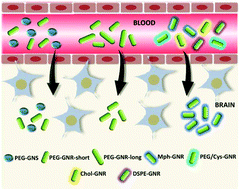Nanoparticle size and chemical modification play a crucial role in the interaction of nano gold with the brain: extent of accumulation and toxicity
Abstract
The blood brain barrier (BBB) is a very selective barrier that protects the brain and the central nervous system (CNS) from the entry of harmful substances and helps regulate the exchange of different molecules and nutrients from and into the brain and the CNS. This selectivity makes delivering therapeutic and diagnostic materials across the BBB very challenging. In this study, different shapes and sizes of gold nanoparticles (GNP) were synthesized and functionalized with five different thiolated ligands to obtain GNP with various surface chemistries. The potential of GNP of different properties to be accumulated into the brain through the BBB and into other organs was investigated in a mouse model using qualitative and quantitative approaches. Gold nanorods (GNR) functionalized with 4-mercaptophenol (Mph) showed the highest penetration ability across the BBB into the brain with no significant deposition in other organs. Interestingly, increasing the size of GNR retarded their delivery into the brain, while enhancing their accumulation in other organs. On the other hand, gold nanospheres (GNS) demonstrated high deposition percentages in the brain and other organs with possible toxic effects. The properties of GNP play a crucial role in their interaction with the BBB and accumulation in the brain and other organs. Thus, GNP can be considered a promising nano-platform for drug delivery into the brain and as a photothermal-inducing agent against brain cancer.



 Please wait while we load your content...
Please wait while we load your content...